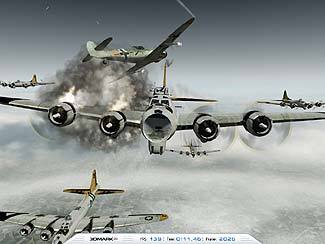3DMark06 Under the Magnifying Glass
Futuremark's Nick Renqvist
Game Test 1 in 3DMark03
We asked Nick Renqvist at Futuremark for some comments on 3DMark06. We decided to interject our questions and his comments throughout this article, because we feel that it is always best to get answers to questions straight from the source. First, we asked Nick about his role with Futuremark, and about the project.
TOM'S HARDWARE: "Nick, what is your role at Futuremark?"
Nick: "My official title is "Benchmark Development Architect", which means I work both internally with our PC benchmarks, and closely with our BDP members. I also do quite a lot of research into new and interesting techniques and technologies."
TOM'S HARDWARE: "How long did Futuremark work on the 3DMark06 project, from start to finish? What were the greatest hurdles to overcome?"
Nick: "It took us roughly 12 months to get 3DMark06 done. In a project as big as 3DMark, it is impossible to pinpoint the hurdles. Coming up with new and innovative effects and techniques is always challenging, since we don't have any real-time reference material on how it should be done. Most of the techniques we use in 3DMark06 are made in-house without any real-time demonstrations.
Let's take the subsurface scattering effect as an example. We had read about it and how to do it, but had never seen it running in real time. It took us some time to get it right and to work as we wanted it. Now, looking at the effect, I think the guys did a great job, and it is an effect I think we will see used in future games. It doesn't cost that much in terms of performance, and if used with the correct settings, it can really up the visual fidelity. For example, in "Deep Freeze", we use it as a part of the snow shader, and without the subsurface scattering effect, the snow simply looks wrong."
Get Tom's Hardware's best news and in-depth reviews, straight to your inbox.
Below is the comparison chart Futuremark has in its 3DMark06 whitepaper.
Here you can see that they changed the suite from three Shader Model 2.0 tests to only two, and added Shader Model 3.0 on two tests with High Dynamic Range (HDR) support. Futuremark added more shadow mapping techniques and multi-CPU support. What hasn't changed much are the first two tests; there is some new artistic work with more details in all of the original three tests, and new shadow paths and higher texture resolutions.
All of these changes attempt to test Shader Model 3.0 graphics cards. In its whitepaper, Futuremark states that "ShaderModel 3.0 (SM3.0) is the new key element of 3DMark06. Though it has been available in DirectX9 for quite some time, it has not been used significantly in any games or applications until recently. It is difficult to pinpoint the reason, but the lack of a wide audience with SM3.0 hardware could be one.
Today we have more Independent Hardware Vendors (IHVs) with SM3.0 compliant hardware, so we expect things to change. SM3.0 opens up a lot of new features to be used; vPos register, dynamic flow control, derivative instructions, and a large number of instruction slots are all key elements of SM3.0, and these are features game developers will be using in their upcoming titles. 3DMark06 uses both SM2.0 and SM3.0 extensively, and uses, by default, the highest compilation profile supported by the hardware, including 3.0. The profile can also be manually selected for interesting performance comparisons between the different profiles."

